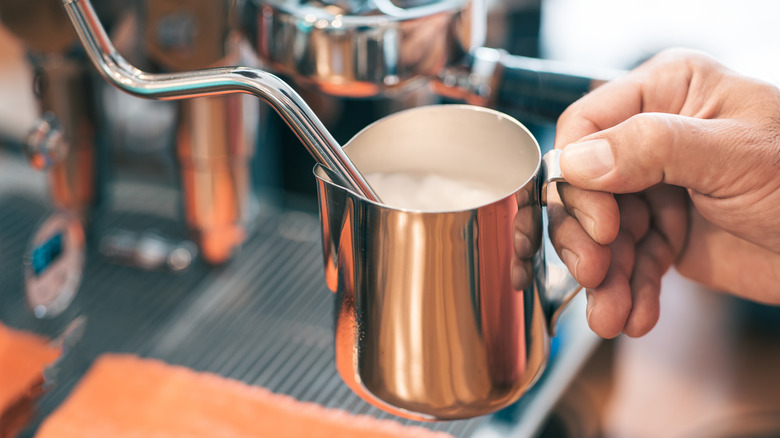The Possible Reason The Steamed Milk In Your Coffee Isn't Creamy
Good steamed milk, the kind that is simultaneously supple, smooth, and thick without being too foamy, is tough to get right. Over-steaming turns milk into dense clouds that "glob" out of the pitcher rather than pour while under-steaming leaves you with thin milk that puddles in the center of your espresso. But, if your milk is coming out runny and thin, your technique isn't necessarily to blame; It might be your steam wand.
Steam wands, ideally, are designed to be the most consistent, precise tool for turning milk into creamy foam (or froth, depending on how deeply you submerge the wand into your milk pitcher). If you're frothing milk at home, chances are you're either using a standalone steam wand or a full espresso machine appliance. Espresso machines hold two separate boilers which run at different temperatures: One for passing through the portafilter and one for the steam wand. In theory, a carefully calculated amount of steam passes through the wand and into the milk, adding slight dilution and warming the milk. But, your steam wand might be dispensing a surplus of water particles, thereby making your milk too watery.
While only about 10% to 15% of the water created by a steam wand will end up in your milk, it's enough to make a difference in your finished craft beverage. Investing in a better quality wand or espresso machine will reduce this figure some, but even with a top-of-the-line model, you're still looking at around 8% added water content.
Be sure to select an optimal type of milk
Different types of milk have different water contents. Soy milk can contain up to 92% water while whole milk has a water content of roughly 88.1%. Meanwhile, oat milk is made with a natural water-soluble plant fiber, which makes it perform better than many other alternative kinds of milk for frothing. Almond milk has a lower fat content and therefore doesn't steam as well.
Under the steam wand, a little extra water content is unavoidable. But, nailing all the other parts of the steaming process will help make up for it. To achieve that elusive, ideal creamy milk structure, start with cold milk (stored at 37 degrees Fahrenheit or below) and a clean, rinsed pitcher. By using milk that starts at a cooler temperature, it will be able to steam for enough time to develop microfoam before overheating and scorching. If your milk looks a little watery post-steam, it may not be you; It really might just be the type of milk you're working with and its molecular composition.
Select your milk carefully and give your wand or espresso machine a maintenance tune-up to elevate your latte game. Depending on how often you craft espresso beverages, it might even be worth it to invest in a better-quality machine or a less-leaky standalone steam wand.

